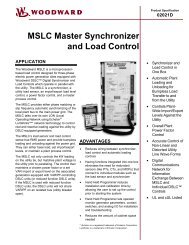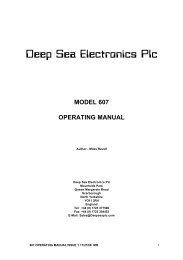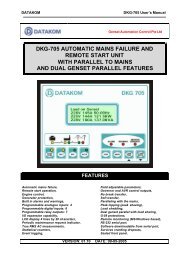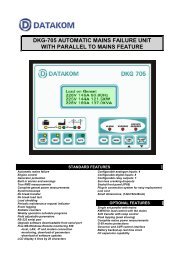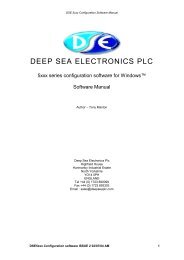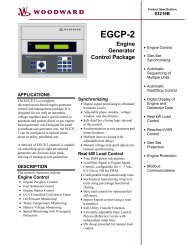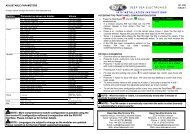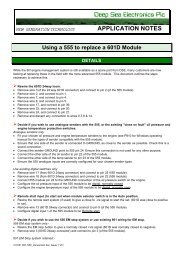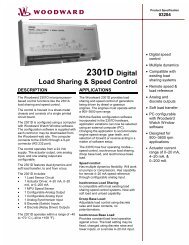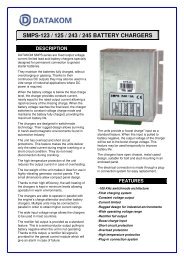DEEP SEA ELECTRONICS PLC - Home Mega Global Solution
DEEP SEA ELECTRONICS PLC - Home Mega Global Solution
DEEP SEA ELECTRONICS PLC - Home Mega Global Solution
You also want an ePaper? Increase the reach of your titles
YUMPU automatically turns print PDFs into web optimized ePapers that Google loves.
8 THE NEED FOR SYNCHRONISINGBefore two or more A.C. supplies can be ‘closed’ together in parallel, the frequency, voltage andphase of the supplies must be matched as closely together as possible. Collectively, frequency andvoltage matching are known as synchronisation, although voltage matching may not be required inall applications.Additionally, the phase rotation of the supplies must be the same, i.e. L1, L2, L3 (Anticlockwiserotation) or L3, L2, L1 (Clockwise rotation). The 55x synchronising and load sharing modules willcheck the phase rotation. If this is wrong, the controller can not act, apart from notifying theoperator with an alarm condition. The fault must be corrected before synchronising of the suppliescan be attempted.Synchronisation is achieved firstly by adjusting theengine speed and generator voltage to get thefrequency and voltage of the generator closelymatched to that of the bus / mains supply.Then the phase angle of the supplies is monitoreduntil it is within an acceptable ‘window’ before thesupplies can be closed together in parallel.In the example to the left, the two supplies (shownby the two sine waves) have very similar frequencies(seen as the distance between the “peaks” of thewaves). However, they have very different voltages(overall heights of the waves) and the supplies arenot in phase (the two supply waves are not “on top”of each other).Typically, a frequency difference (called slip frequency) of 0.2Hz, a voltage difference of 5% and aphase angle of 5° will allow for satisfactory paralleling of the supplies.Once the supplies are closed in parallel, the phase of the supplies will not alter, they are ‘locked’ inparallel together.WARNING! Attempting to close the supplies in parallel when they are not insynchronism can result in damage to the generating set system.For example: If synchronising (using two gensets) is effected 120° out of phase, thecoupling torque can be as high as 12 times full load torque, depending on the ratio ofengine and generator inertias (Source: Diesel Generator Handbook L.L.J. Mahon).The actual synchronising process can be achieved through various methods. Put simply, eachmethod involves manipulating the engine governor to increase/decrease engine speed (which hasa direct relationship with generator frequency) and the Automatic Voltage Regulator (whichcontrols the alternator excitation field to produce voltage).The engine governor determines engine speed, by sensing the speed of rotation of the flywheel(normally using a magnetic pickup probe). The governor can then control the actuator to adjust theamount of fuel into the engine, which changes engine speed (similar to the accelerator in a car).Most governors are also fitted with a ‘remote speed adjust’ input to allow an external device toincrease or decrease the set speed of the engine.The Automatic Voltage Regulator effects change in the generator output voltage by controlling thealternator’s exciter field. The AVR adjusts the voltage output to the required set voltage. MostAVRs are also fitted with a ‘remote volts adjust’ input to allow an external device to increase ordecrease the set voltage of the alternator.Automatic synchronisers act upon the ‘remote speed adjust’ and ‘remote volts adjust’ inputs of thegovernor and AVR to affect synchronism and voltage matching.The method of interface between the automatic synchroniser and the governor/AVR depends uponthe type of governor and AVR being used, and are described in the section entitled “Methods ofAdjusting Voltage and Frequency”.DSE Guide to Synchronising & Load Sharing PART 1 ISSUE5 18/3/04 AM 21




